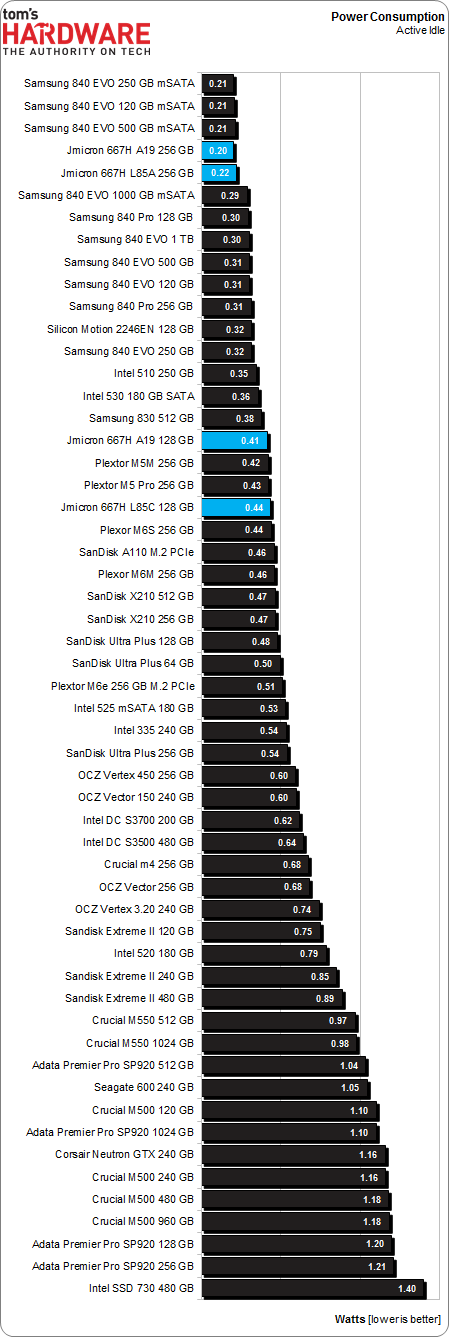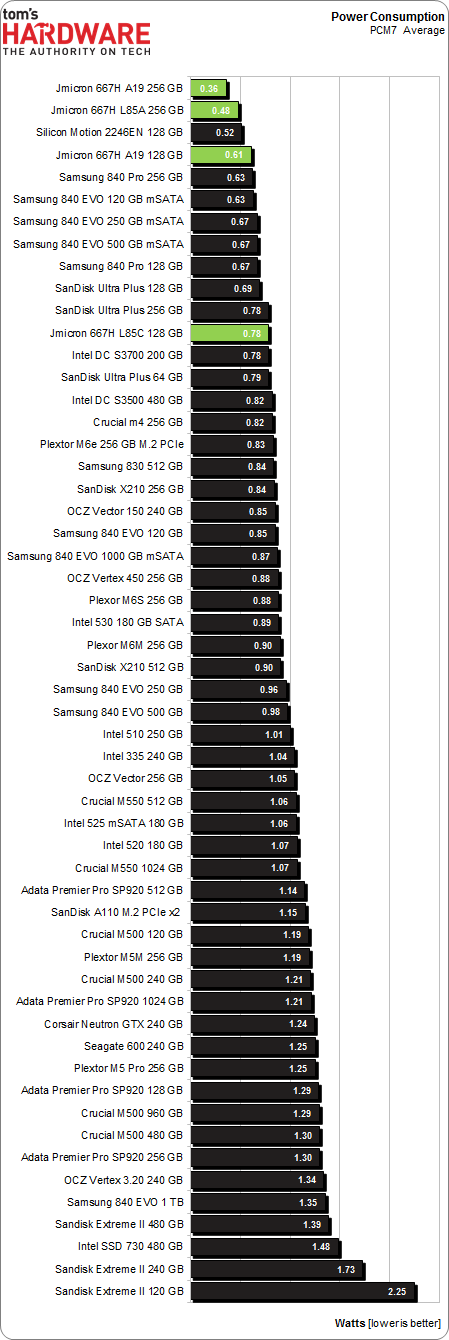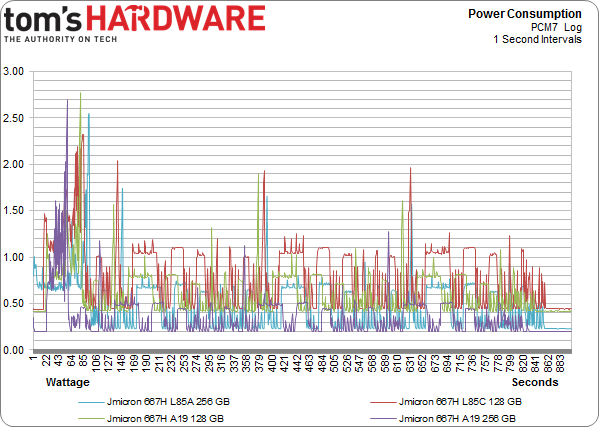JMicron Returns: The JMF667H Controller On Four Reference SSDs
It's rare that we get the chance to test SSDs before they hit production. But after waltzing with Silicon Motion's SM2246EN platform last year, JMicron offered us a handful of reference drives with different types of flash, all driven by the new JMF667H.
Power Testing: Now With 73% More DevSlp
Active Idle Power Consumption
Idle consumption is the most important power metric for consumer and client SSDs. After all, solid-state drives complete host commands quickly and then drop back down to idle. Aside from the occasional background garbage collection, a modern SSD spends most of its life doing very little. Enterprise-oriented drives are more frequently used at full tilt, making their idle power numbers less relevant. But this just isn't the case on the desktop, where the demands of client and consumer computing leave most SSDs sitting on their hands for long stretches of time.
Active idle power numbers are critical, especially when it comes to their impact on mobile platforms. Idle means different things on different systems, though. Pretty much every drive we're testing is capable of one or more low-power states, up to and including DevSlp. That last feature is a part of the SATA 3.1 host specification. And while it requires a capable SSD and a compatible platform, enabling DevSlp takes power consumption down to a very small number.
Interestingly, I measure consistently different active idle states for the JMicron reference drives. The two 128 GB configurations land in the .4 W range, while both 256 GB SSDs idle closer to .2 W. For drives with twice as much NAND, that's seemingly weird.
PCMark 7 Average Power Consumption
If we log power consumption through a workload, even a relatively heavy one, we see that average use is still pretty close to the idle numbers. Maximum power may spike fiercely, but the draw during a PCMark 7 run is light. You can see the drives fall back down to the idle "floor" between peaks of varying intensity.
At this point, it's tempting to suspect something is wrong. But it's not. The two 256 GB JMF667H-based drives again use substantially less power (on average) through the run, thanks largely to the low idle power consumption already observed.
Get Tom's Hardware's best news and in-depth reviews, straight to your inbox.
After a lot of power testing, logging, and Excel work, we end up with the above chart. It's not particularly readable, but that just lends to its air of mystery, right? We've heard plenty of readers like Chris Angelini's power charts in his CPU reviews; this is something similar for you.
But it's beyond me why the disparity in idle power use is so pronounced. This has to be an artifact of JMicron's JMF667H-based reference platforms and the on-board components though, though. To conclude then, these drives appear super efficient overall, and it bothers me that the drives are so different at idle. But the outcome doesn't truly become significant until we can start getting our hands on more retail hardware employing JMicron's processor.
Current page: Power Testing: Now With 73% More DevSlp
Prev Page Results: TRIM Testing With DriveMaster 2012 Next Page JMicron's JMF667H Steps Up To Redeem A Troubled Name-
Snipergod87 Page 6: "For every 1 GB the host asked to be written, Mushkin's drive is forced to write 1.05 GB."Reply
Mushkin drive?, To much copy paste. -
koolkei guys. please take a look at thisReply
http://www.tweaktown.com/reviews/6052/kingfast-c-drive-f8-series-240gb-ssd-review-cheapest-tested-240gb-drive-so-far/index.html
that's an actual SSD using this controller, and the price is........ a little more than surprising... -
pjmelect I remember their USB to IDE SATA chip. It caused data corruption every 4 GB or so when transferring data via the IDE interface. I have always been wary of their products since then.Reply -
tripleX "But we're not going to use theoretical corner cases (the sequential and random 4 KB benchmarks we just ran) to crown one configuration a winner and another a loser."Reply
A corner case is not sequential and random benchmarks. It is an engineering term that means, according to Wiki:
A corner case (or pathological case) is a problem or situation that occurs only outside of normal operating parameters—specifically one that manifests itself when multiple environmental variables or conditions are simultaneously at extreme levels, even though each parameter is within the specified range for that parameter.
-
g00ey JMicron has always made pretty shitty products so I won´'t buy any of these anytime soon...Reply -
2Be_or_Not2Be I, too, find it hard to want to purchase a drive from a manufacturer with such a lackluster history.Reply
One part of this article that also doesn't make sense: "Why four channels and not eight? Efficiency is one key motivator. Fewer channels facilitate a smaller ASIC, which can, in turn, be more power-friendly." Compare the size of the PCB to one like the Samsung 850 Pro. They aren't saving much in real estate (they are actually bigger than the Samsung boards), so it makes it hard to believe they're saving much in power here.


